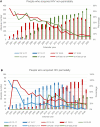Long-Term Virological Treatment Outcomes in Adolescents and Young Adults With Perinatally and Non-Perinatally Acquired Human Immunodeficiency Virus
- PMID: 36447610
- PMCID: PMC9697590
- DOI: 10.1093/ofid/ofac561
Long-Term Virological Treatment Outcomes in Adolescents and Young Adults With Perinatally and Non-Perinatally Acquired Human Immunodeficiency Virus
Abstract
Background: Long-term viral suppression on antiretroviral therapy (ART) is not established among all people with human immunodeficiency virus (PWH). Young adults (18-24 years) are recognized as a group vulnerable for suboptimal virological treatment outcomes. The aim of this study is to evaluate longitudinal virological treatment outcomes and to identify risk factors for virological failure (VF) among young adults with non-perinatally and perinatally acquired human immunodeficiency virus (HIV) in the Netherlands.
Methods: We included individuals registered in the national ATHENA observational cohort from 2000 until 2020 who had entered care before the age of 25 years, who had received ART for at least 6 months with at least 2 available HIV ribonucleic acid measurements between the age of 18 and 24 years. We compared VF between age groups 12-17, 18-24, and 25-30 years. A multivariable generalized linear mixed model was used to evaluate risk factors for VF. Analyses were stratified by HIV acquisition mode.
Results: In total, 1174 non-perinatally PWH and 157 perinatally PWH were included. In 2020, VF rate was 7% in non-perinatally PWH young adults and 19% in perinatally PWH young adults. The adjusted risk for VF was significantly higher in those aged 18-24 compared to 25-30 years in both non-perinatally PWH (odds ratio [OR], 1.27; 95% confidence interval [CI], 1.07-1.50) and perinatally PWH (OR, 2.34; 95% CI, 1.48-3.71).
Conclusions: Young adulthood is a vulnerable period, with increased risk for VF, especially for perinatally PWH. The probability of VF decreased over time, but less for perinatally PWH compared to non-perinatally PWH.
Keywords: HIV; antiretroviral therapy; longitudinal study; viral suppression; young adults.
© The Author(s) 2022. Published by Oxford University Press on behalf of Infectious Diseases Society of America.
Conflict of interest statement
Potential conflicts of interest. M. v. d. V. has received consultancy fees and research grants from Gilead, MSD, and ViiV all paid to his institution. F. W. N. M. W. has served on a scientific advisory board for ViiV Healthcare. J. F. J. B. N. has received fees, paid to the institution, for educational activities from BMS, Gilead, ViiV Healthcare, and GSK. All authors have submitted the ICMJE Form for Disclosure of Potential Conflicts of Interest. Conflicts that the editors consider relevant to the content of the manuscript have been disclosed.
Figures


References
-
- UNAIDS . UNAIDS factsheet 2021. Available at: https://www.unaids.org/en/resources/fact-sheet. Accessed 13 January 2022.
-
- World Health Organisation . Recognizing adolescence. Available at: https://apps.who.int/adolescent/second-decade/section2/page1/recognizing.... Accessed 4 May 2022.
-
- United Nations Population Fund . Adolescent and youth demographics: a brief overview. Available at: https://unfpa.org/sites/default/files/resource-pdf/One%20pager%20on%20yo.... Accessed 4 May 2022.

